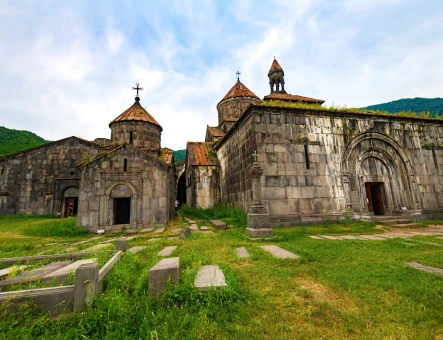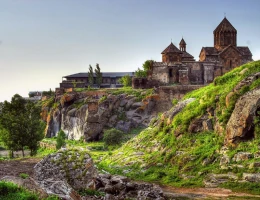Private tour: Six wonderful regions of Armenia in 3 days
Haghpat Monastery, Sanahin Monastery, Akhtala Fortress, Dilijan
1. Haghpat Monastery
50-60 min





























2. Sanahin Monastery
40-50 min



















3. Akhtala Fortress
40-50 min






















4. Dilijan
20-30 min


























Haghartsin Monastery, Goshavank Monastery, Lake Sevan, Sevanavank Monastery, Jermuk
1. Haghartsin Monastery
60-70 min























2. Goshavank Monastery
40-50 min















3. Lake Sevan
























4. Sevanavank Monastery
50-60 min























5. Jermuk



























Jermuk, Jermuk Waterfall, "Wings of Tatev" Ropeway, Tatev Monastery, Noravank Monastery, Yerevan
1. Jermuk
50-60 min


























2. Jermuk Waterfall
20-30 min











That is why Jermuk waterfall is sometimes referred to as "The mermaid's hair".
The most favorable season to visit waterfalls is from the end of March till June, as the water flow force is on its highest level during that period.
3. Wings of Tatev Ropeway
10-15 min















"Wings of Tatev" is the world's longest reversible aerial tramway, officially recognized by the Guinness World Records.
4. Tatev Monastery
50-60 min

























5. Noravank Monastery
50-60 min



























Inclusions
-
Professional drivers
-
Air-conditioned vehicles
-
Bottled water
-
Free pick-up & drop-off within Yerevan
-
Vehicle & passengers insurance
-
Extra stops on the route upon request
-
Driver/Guide accommodation & meals
Exclusions
-
Hotel accommodation
-
Significant deviations from the route
-
Alcoholic beverages if lunch option selected
-
Audio guides
-
Wi-Fi in the vehicles
What to expect
- Explore incredible UNESCO World Cultural Heritage sites
- Admire the forests of the "Armenian Switzerland"
- Visit one of the largest freshwater high-altitude lakes in Eurasia
- Enjoy the fresh and clean vibes of the waterfall
- Experience the flight on the longest reversible cableway in the World, recorded in the Guinness Book of Records
*200 steps to climb to Sevanavank
*600 m to walk up to the hill to Haghartsin
*This tour is NOT recommended for people with high blood pressure
Booking conditions
Cancellation & modification
Meet our Guides

Arpine Khalatyan
My name is Arpi. With experience in guiding since 2015, fluency in English and Russian, and a wealth of knowledge in history and culture, I offer engaging and informative tours during which you'll explore Armenia and feel the greatest vibes ever.

Davit Hasratyan
I'm Davit, a history teacher, amateur actor, and since 2010, a guide at "Hyur Service"! I love my country and strive to make every tour I conduct leave an unforgettable impression on our guests, making them want to come back again and again!

Karen Khachatryan
Dear friends, my name is Karen, and I am your guide through the amazing Armenia. My many years of experience allow me to conduct fascinating tours to the most popular and interesting places in the country. I bring history to life, sing psalms in ancient churches, and tell captivating legends, making your journey unforgettable. With me, you can expect a safe, informative, and vibrant trip!

Khachatur Mirzoyan
My name is Khachatur, which is the Armenian variation of Chris (Christopher), and I'm comfortable with that as well. I have been working as a tour guide since 2012. I'm a sociable person, love interacting with people, and always do my best to make sure the tour lives up to our guests' expectations.



